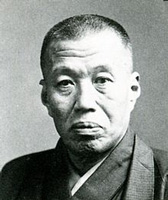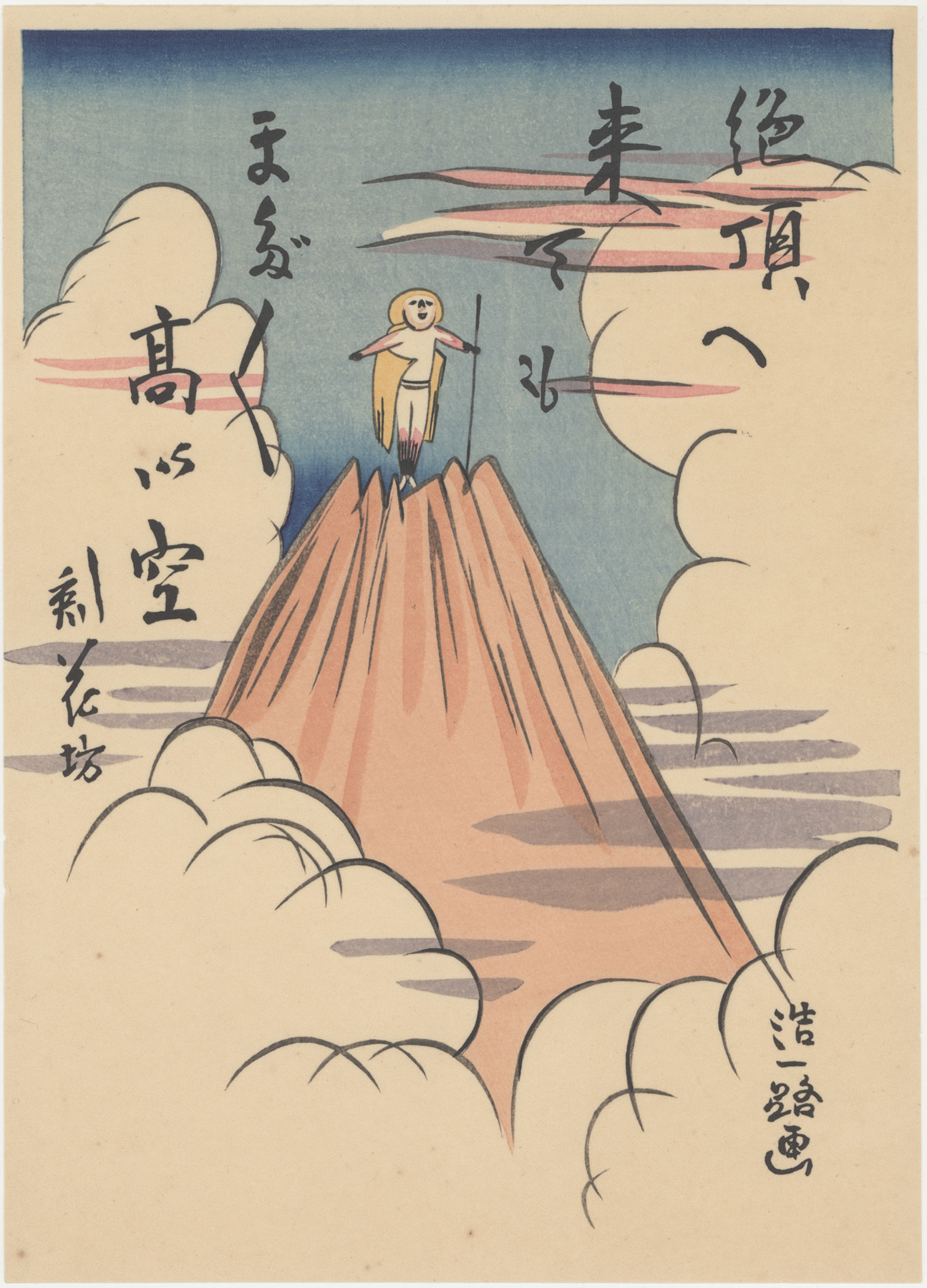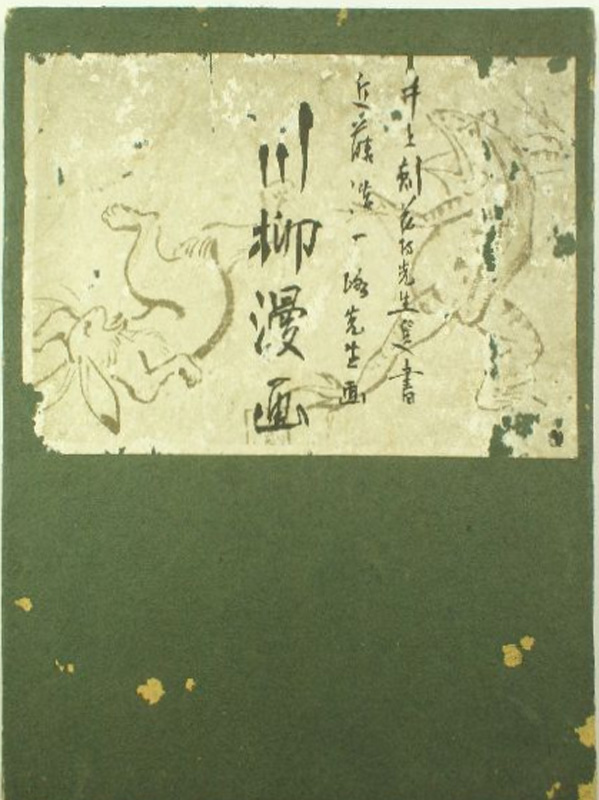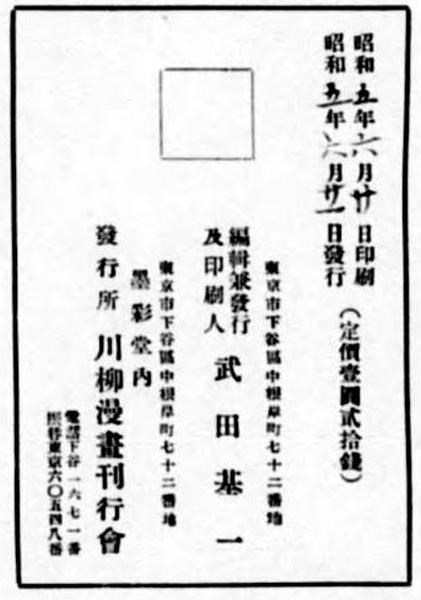About This Print
Since a senryu is very short, one might think that the translation is simple. On the contrary, the translation is quite difficult for that very reason. In order to make a poem short, the senryu poets economize words and cut off explanatory expressions. If the readers share the same culture, it is easy for them to understand the poem's message. If not, the poem is hard to figure out and sometimes incomprehensible.
[source: "A Record of Life and a Poem of Sentiments": Japanese Immigrant "Senryu," 1929-1945, appearing in Amerikastudien / American Studies , 2006, Vol. 51, No. 1, Multilingualism and American Studies (2006), pp. 29-49 Published by: Universitätsverlag WINTER Gmbh.]
This print is one of at least forty prints created by the painter/manga artist Kondō Kōichiro 近藤浩一路 (1884–1962) and the poet/journalist Inoue Kenkabō 井上剣花坊 (1870-1934) in 1930, which pair a senryū, almost all of which were written by Kenkabō, with an illustration by Kondō. In this print the senryū reads 絶頂へ 來 ても まだ〱 高い空 - "Even reaching the top/summit, the sky is still higher" - and the illustration pictures a self-satisfied climber on a mountain's summit.
About The Series Senryū manga
In 1930 the painter/manga artist Kondō Kōichiro (1884–1962) and the poet/journalist Kenkabō Inoue (1870-1934) collaborated on a series of at least forty woodblock prints containing Kenkabō's senryū (short humorous verse), or those he has chosen by other poets, along with Kondō's illustrations, titled Senryū manga 川柳漫画. The prints seem to have been grouped together in portfolios rather than sold individually and were published by Senryū Manga Kankōkai 川柳漫画刊行会 , most likely a creation of the two artists.
The National Diet Library has several prints from this series in their collection along with images of a portfolio cover, table of contents (although the table of contents does not match the prints they show as being in the portfolio) and colophon. (Go to http://dl.ndl.go.jp/info:ndljp/pid/1015589 to see their holding and see the pictures below.)
click on image to enlarge
source: National Diet Library
table of contents
日本美術院同人近藤浩一路氏畫
Kondō Kōichiro, member of Nihon Bijutsuin
柳樽寺井上剣花坊氏撰書
Ryūsonji Inoue Kenabō editor and writer
川柳漫畫第二集豫定
Senryū manga, second collection
followed by the listing of four senryū
以上
{一部賣定價金壹圓貳拾錢
繼續會員に限り金 壹 圓}
[pricing structure]
What are Senryū?
Sources: Light Verse from the Floating World, Makoto Ueda, Columbia University Press, 1999, p. 32-33; Senryu Japanese Satirical Verses, R. H. Blyth, The Hokuseido Press, 1949.
A senryū is the expression of a moment of psychological insight into the life of human beings; nature is either absent or a mere background. Like haiku, it is a short unrhymed verse with the 5–7–5 syllable pattern. Unlike haiku, however, it requires no word implying the season of the year, as it draws less on nature than on human nature. Whereas a haiku poet in general tries to capture a moment of insight into the mysterious workings of the natural world, a writer of senryū keenly studies various aspects of the human condition and reports his findings in a humorous way, the humor sometimes crossing over to the territory of satire.
The word senryū is derived from the name of a person, Karai Senryū (1718–1790), who lived in the downtown district of Edo. His real name was Karai Hachiemon, and he made a living as the head official of his ward. In 1757, for unknown reasons, he decided to make a debut as a master of maekuzuke, a verse-writing game played by a good many people in Japan at that time. Senryū, which literally means “river willow,” was the professional name he adopted on becoming a master.
The revitalization and modernization of senryū in the early 1900s is credited to two journalists who worked for the daily newspaper Nihon Shimbun. The first, Sakai Kuraki (1869–1945), promoted the restoration of the free spirit of senryū. His successor at the paper, Inoue Kenkabō (1870–1934), encouraged senryūwriters to take up topics characteristic of the emerging new society through his column called “Shindai yanagidaru” (Yanagidaru on Modern Topics).
Less than one year after the inauguration of Inoue's column, the number of contributors of senryū to the paper had increased to more than three hundred. Soon senryū groups were being organized all over Japan, many of them starting their own magazines. By 1912, the number of such magazines published in Japan had reached fifty. Many major newspapers, weeklies, and monthlies also came to devote space to their readers’ senryū. The trend accelerated with time so that in 1935 of the more than two hundred national and local newspapers almost all had space dedicated to senryū.Source: http://archive.li/f08u7
 | Inoue Kenkabō (1870-1934), writer of senryū (short, humorous verse), was born in Yamaguchi Prefecture in 1870. His real name was Inoue Koichi. After working as a substitute elementary school teacher and a reporter for a local newspaper, he moved to Tokyo in 1900 and began writing the arts column for the magazine, Myogi. Three years later, he joined the Nihon Shimbun newspaper. Using the pen name, Kenkabō, he began a column called Shindai yanagidaru, which advocated a new style of senryū. In 1905, he founded a circle known as Ryūsonji Senryū Kai, which brought out its own magazine, Senryū. After retiring from Nihon Shimbun, Kenkabō continued to run the senryū sections of the Kokumin and Yomiuri newspapers and resurrected Senryū in 1912, renaming it Taisho Senryū, |
Print Details
| IHL Catalog | #1545 | ||
| Title/Description | Even reaching the top/summit, the sky is still higher 絶頂へ來てもまだ〱高い空 zetchō e kitemo madamada takai sora | ||
| Series | Senryū manga 川柳漫画 | ||
| Artist | Kondō Kōichiro (1884–1962) | ||
| Signatures |
| ||
| Seal | none | ||
| Date | June 21, 1930 明治五年六月廿日印刷 Showa 5th year 6th month, 20th day, printed 明治五年六月廿一日発行 Showa 5th year 6th month, 21st day, issued (dates are taken from the table of contents of the portfolio in the collection of the National Diet Library) | ||
| Edition | first and only | ||
| Publisher | 川柳漫画刊行会 Senryū Manga Kankōkai | ||
| Printer | 印刷人武田基一 printer Takeda Kiichi | ||
| Impression | excellent | ||
| Colors | excellent | ||
| Condition | excellent | ||
| Miscellaneous | | ||
| Genre | senryū manga | ||
| Format | chuban | ||
| H x W Paper | 9 7/16 x 6 13/16 in. (24 x 17.3 cm) | ||
| H x W Image | 9 1/4 x 6 1/2 in. (23.5 x 16.5 cm) | ||
| Collections This Print | |||
| Reference Literature |







